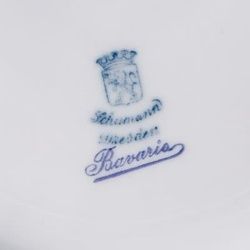
Фабрика Шайбе-Альсбах (Шайбэ-Альсбах, Scheibe-Alsbach).
Основана в Тюрингии в 1835 г . Людвигом Оелсом (Ludwig Oels) и уже через несколько десятилетий приобрела мировую известность: с 1857 года она широко известна как первая тюрингская фабрика, изготовляющая фигуры большого размера (в основном религиозного толка - Мадонн) , надгробий, а также бюсты известных поэтов и композиторов, анималистические композиции и изделия в стиле рококо и бидермайер. С 1863 года владелец фабрики - А.В. Кистер (A.W.F. Kister), название фабрики сменилось на Porzellanmanufaktur A.W.F. Kister и просуществовало до 1962 года, В 1972 году фабрика была национализирована, вошла в объединение тонкого фарфора в Лихте.
Изделия фабрики получили 2 серебряных медали и 6 Гран-при на национальных и международных выставках, а в 1911 году - 12 золотых медалей на выставке в Турине (Италия). Производство ведётся исключительно ручным способом. Выпускается фигурный фарфор: бюсты поэтов и композиторов, фигуры животных, танцующие фигуры и т.д. (от классических композиций до исторических сцен), а также вазы, светильники и надгробия. Отборное сырьё, высококачественный фарфор особого сорта и улучшенная технология полировки позволяют изготавливать фигурки, продуманные до мельчайших деталей.
Тонваренфабрик Генрих Шуман (1876 - 1879 гг.)
Родом из Ангелроды (Тюрингия) Христиан Генрих Шуман (* 1822, † 1884) имел небольшую гончарную мастерскую в Арцберге, которую пришлось закрыть, потому что она мешала прокладке железной дороги, которая была завершена в ноябре 1879 года и соединила Арцберг с железнодорожной сетью.
Porzellanfabrik Schumann & Riess (с 1881 по 1892 год).
Вместе с бизнесменом Риссом в качестве финансового спонсора Кристиан Генрих Шуман основал свою новую фабрику по производству фарфора прямо под замком Якобсбург, рядом с рыночной площадью в центре города и, по иронии судьбы, прямо рядом с железнодорожными путями, из-за которых закрылся его предыдущий бизнес. Из четырех детей Кристиана Генриха Шумана и его жены Кристианы (*1838, †1928) только трое оказали влияние на дальнейшую историю компании.
Только младший ребенок по имени Карл (*1871, †1926) по-настоящему интересовался фабрикой и хозяйственными делами, а старший сын Кристоф (*1864, †1916) время от времени помогал, но часто заводил бесконечные дискуссии о том, как завод должен работать. Третий сын Эдуард, напротив, держался в стороне и сосредоточился на учебе.
В такой ситуации было только понятно, что незадолго до смерти Христиана Генриха Шумана в 1884 году он заявил, что Карл должен унаследовать фабрику, поскольку он не только проявлял наибольший интерес, но и не раз производил впечатление на своего отца техническими знаниями и способностью быстро адаптироваться к различным ситуациям. Однако Карл был недостаточно взрослым, чтобы официально заняться бизнесом, когда умер его отец, и поэтому компанией руководила его мать Кристиана.
Porzellanfabrik Carl Schumann G.m.b.H. & Co. KG. (с 1892 по 1923 год)
Фабрика была переименована в 21-й день рождения Карла Шумана I, однако его мать по-прежнему оставалась у власти, пока не ушла в отставку в 1896 году, когда Карл женился. Бизнес неуклонно рос, и поэтому Карл, как специалист по фарфору, вместе со своим братом Эдуардом в качестве менеджера открыли второй бизнес в 1904 году, Westdeutsche Porzellanfabrik Duisdorf GmbH в Дуйсдорфе недалеко от Бонна (Северный Рейн-Вестфалия). Кристоф Шуман ранее женился на богатой семье землевладельцев Шрайдер в городе Шварценхаммер и в 1905 году вместе со своим тестем Карлом Августом Шрайдером основал там ⇒Porzellanfabrik Schumann & Schreider.
Прошли годы, и бизнес неуклонно рос, что позволило компании построить библиотеку и столовую для своих сотрудников, а также обеспечить дешевым жильем сотрудников, которые изначально жили подальше. Благодаря своей общественной деятельности Карл Шуман I со временем стал тайным советником в Арцберге, а двух его сыновей Генриха и Карла Шуманов II (*1898, †1975) часто видели на фабрике, жадно поглощающих знания.
Porzellanfabrik Carl Schumann AG (с 1923 по 1994 год).
19 июля 1923 года компания была преобразована в корпорацию, и все казалось бы хорошо, но три года спустя Карл Шуман I умер в возрасте всего 55 лет. Ему наследовал его сын Карл Шуман II, который в то время учился в Америке и позже основал Schumann China Corporation в Нью-Йорке, которая распространяла продукцию Schumann в США вплоть до конца 1920-х годов. Во время его отсутствия заводом руководил его брат Генрих. В то время как новый рынок в США поначалу казался очень многообещающим, мировой финансовый кризис, начавшийся в Нью-Йорке 25 октября 1929 года, положил драматический конец почти всем экспортным усилиям Шумана. Но «тыл» был не намного лучше, и относительно недолговечный бизнес в Дуйсдорфе, который специализировался на украшениях «Zwiebelmuster» (Синий лук) и «Strohblume» (Соломенный цветок), оставался в руках семьи только до 1935 года, прежде чем он был продан по экономическим причинам.
Следует отметить, что у фирмы Carl Schumann были довольно интересные деловые отношения с фирмами из США, и фабрика была одной из немногих, производивших продукцию для Ebeling & Reuss, которая затем продавалась под маркой Erphila Germany. Еще один малоизвестный факт заключается в том, что Фарфоровая фабрика Карла Шумана A.G. была одной из немногих немецких компаний, которым было разрешено производить фигурки Микки Мауса по лицензии Disney. Для продвижения этих фарфоровых изделий они использовали красивую рекламу, созданную Zereiss & Co., с изображением маленьких Микки, исполняющих традиционный баварский танец. Большинство этих так называемых «неарийских» продуктов были уничтожены в период Третьего рейха с 1934 по 1945 год и поэтому являются одними из самых редких европейских довоенных предметов коллекционирования Диснея.
После Второй мировой войны компания поддержала многих бывших судетских немцев, предложив жилье и работу, а после основания домостроительной компании Schumann-Wohnungsbau GmbH в 1950 году в конечном итоге попыталась повторить прежний успех, достигнув максимального числа рабочих в 1053 рабочих и 70 наемных служащих в 1953/1954. В то время на заводе использовались три круглые печи, а также три комплектные туннельные печи, так как для местной марки требовалось много предметов.







